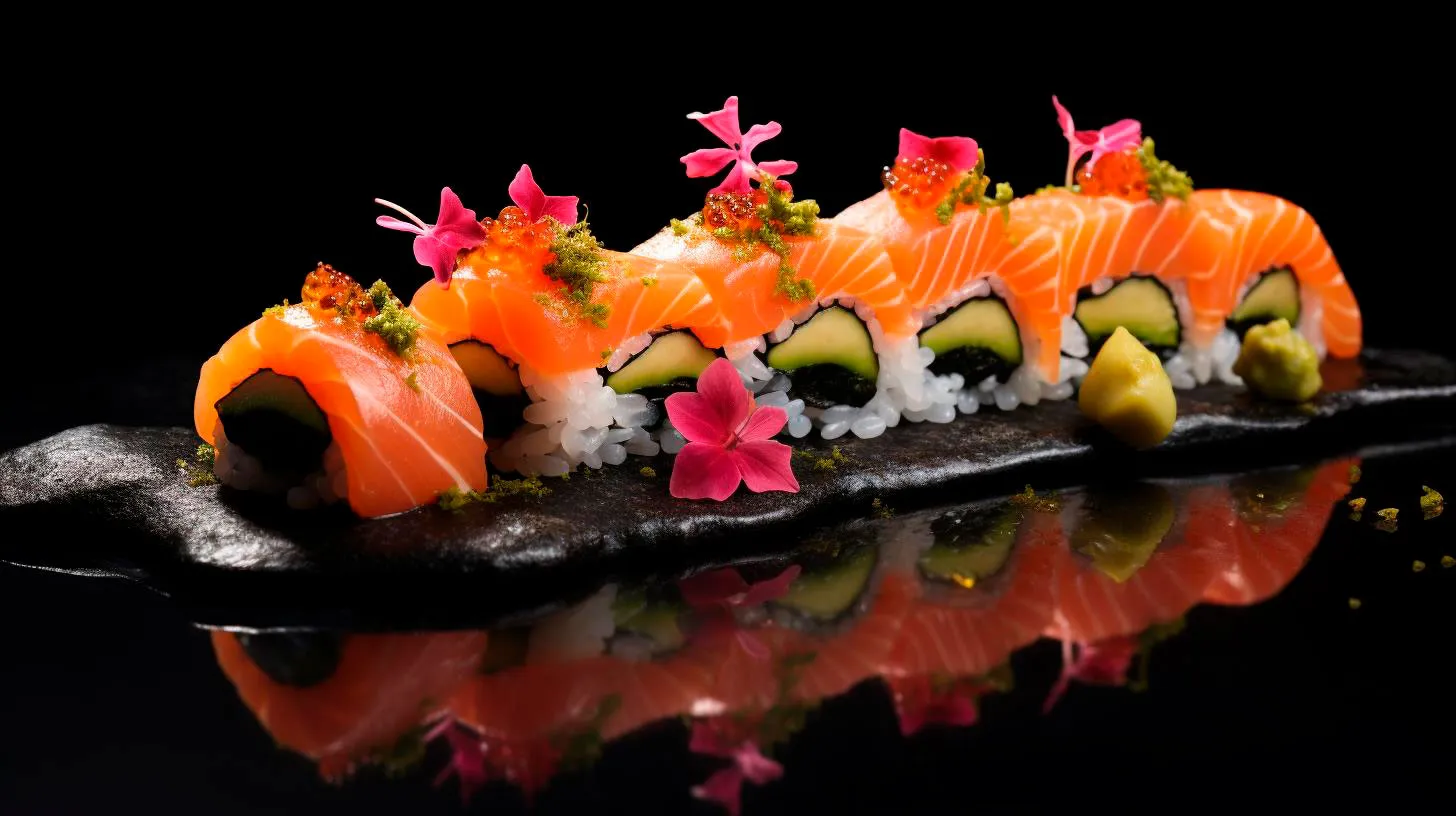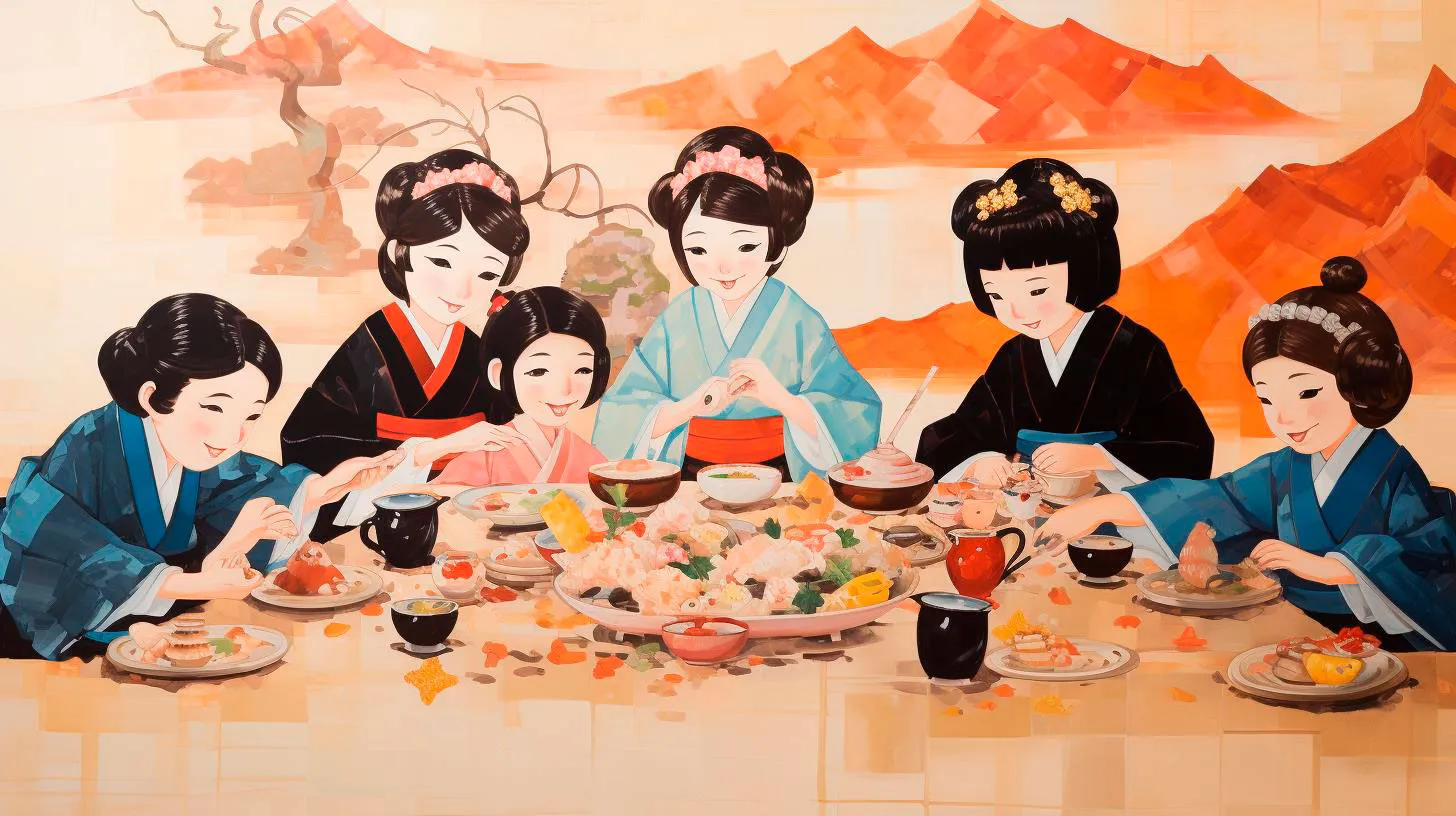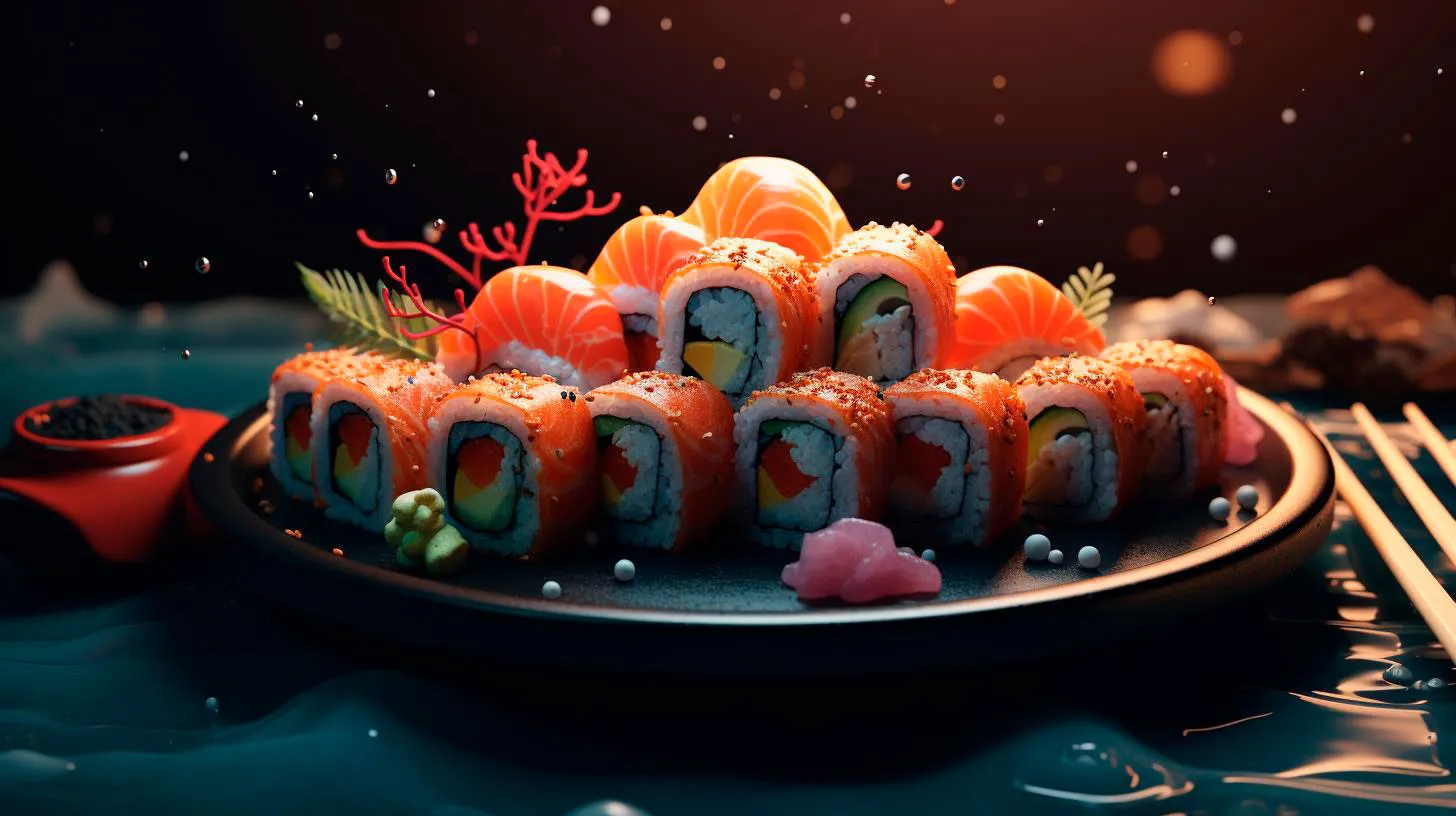The Legacy of Sushi: Exploring Japan’s Culinary Tradition
The Origins: From Simple Preservation to Culinary Delight
The roots of sushi can be traced back to 4th century Japan. Originally, sushi was a method for preserving fish by fermenting it with rice. This process allowed the fish to be stored and eaten later. Over time, sushi evolved from a preservation technique to a delicacy. The fermentation aspect was gradually eliminated, and the focus shifted to enhancing the flavors and textures of the ingredients.
During the Edo period (1603-1868), sushi became a popular street food in Tokyo. It was during this time that nigiri sushi, the most recognizable form of sushi today, was developed. Nigiri sushi consists of a small mound of vinegared rice topped with fresh fish or other ingredients. This style of sushi aimed at showcasing the natural flavors of the fish, highlighting simplicity and quality.
Key Takeaway: Sushi originated as a preservation method and later transformed into a culinary delight. Nigiri sushi became popular during the Edo period, emphasizing simplicity and quality.
The Art of Sushi: Meticulous Preparation Techniques
Sushi is not just a culinary experience; it is also a form of art. Skilled sushi chefs, known as itamae, meticulously prepare each piece of sushi. From selecting the freshest ingredients to mastering the proper rice texture, every step in the preparation process requires precision and attention to detail.
One important aspect of sushi preparation is the rice. Japanese short-grain rice, combined with vinegar, sugar, and salt, forms the base for sushi. Achieving the perfect balance of flavors and texture is crucial to a successful sushi experience. The rice should be slightly sticky, allowing it to hold its shape while being eaten.
Another essential aspect of sushi-making is the fish. Sushi chefs carefully select the freshest fish available. Whether it is tuna, salmon, or uni (sea urchin), the quality and freshness of the fish play a significant role in the overall taste of the sushi. Properly slicing the fish requires years of practice to achieve the ideal thickness and texture.
Key Takeaway: Sushi preparation requires meticulous attention to detail, from selecting the finest ingredients to achieving the perfect rice texture and cutting the fish with precision.
Sushi’s Global Impact: A Worldwide Culinary Phenomenon
Today, sushi has become a global culinary phenomenon, with countless sushi restaurants popping up in cities around the world. Its popularity can be attributed to its unique flavors and the increasing interest in healthy eating.
According to a survey conducted by the Japan External Trade Organization (JETRO), the global sushi market reached a value of $14.9 billion in 2020. This staggering figure highlights the continued growth and demand for this traditional Japanese dish. The United States alone accounted for 40% of the overall global sushi market.
Sushi’s popularity can be attributed to several factors:
- Healthy Eating: Sushi is generally considered a healthy food option. It is low in calories, high in omega-3 fatty acids, and packed with essential vitamins and minerals.
- Variety: Sushi offers a wide range of options to suit different tastes and dietary preferences. From vegetarian rolls to sashimi platters, there is something for everyone.
- Social Experience: Sushi dining often involves shared plates and communal dining, making it a social and interactive experience.
- Visual Appeal: Sushi’s artful presentation adds to its allure. The vibrant colors and meticulous arrangements make it visually appealing and Instagram-worthy.
Key Takeaway: Sushi’s global popularity can be attributed to its health benefits, variety, social appeal, and visually pleasing presentation.
The Future of Sushi: Innovation and Tradition
As sushi continues to evolve, chefs are constantly pushing the boundaries of tradition while honoring its roots. Sushi fusion has become a trend, combining traditional techniques with local ingredients and flavors from different cuisines. This innovative approach presents new and exciting ways to enjoy sushi while keeping its essence intact.
Technology has also made its mark on the sushi industry. Sushi-making robots have been developed to increase efficiency and consistency, especially in high-demand sushi restaurants. While these advancements streamline the process, they also raise questions about the preservation of craftsmanship and the human touch that defines the art of sushi-making.
Despite modern innovations, the foundation of sushi remains deeply rooted in tradition. The meticulous dedication to quality and the respect for ingredients are values that continue to define the legacy of sushi, ensuring its enduring appeal.
Key Takeaway: Sushi continues to evolve through innovation and fusion, while traditional values of quality and respect for ingredients remain at its core.
In conclusion, sushi’s legacy stretches back centuries, evolving from a preservation technique to a cherished culinary art form. Its meticulous preparation techniques, emphasis on quality ingredients, and cultural significance have propelled it to become a global phenomenon. As sushi continues to captivate the world, it is an ever-evolving testament to the rich culinary tradition of Japan.
Preserving Authenticity: Regional Varieties as Cultural Treasures of Japan
With the advent of globalization, it becomes increasingly important to preserve these regional varieties, as they play a crucial role in defining Japan’s cultural identity. In this article, we will delve into the significance of preserving authenticity and explore how these regional varieties can be safeguarded for future generations.
The Cultural Significance of Regional Varieties
Japan’s cultural landscape is characterized by the immense diversity present within its regions. Each area has its unique customs, dialects, arts, and crafts, granting visitors an insight into the country’s historical and traditional tapestry. Preserving these regional varieties is not only vital for cultural identity but also for tourism and the economy. Here are some key reasons why preserving authenticity matters:
- Cultural Identity: Regional varieties are the essence of Japan’s cultural identity. The distinct customs and traditions passed down through generations reflect the soul of each region, showcasing the importance of preserving and celebrating this diversity.
- Tourism Appeal: Regional varieties contribute significantly to tourism in Japan. Travelers, both domestic and international, are drawn to the unique experiences offered by each region. Preserving authenticity helps in sustaining and growing this vital industry.
- Economic Impact: Regional specialties, such as local cuisines, handicrafts, and traditional industries, bolster local economies. By protecting and promoting these regional treasures, Japan can ensure the economic prosperity of its different regions.
Preservation Initiatives: A Step Towards Safeguarding Authenticity
The preservation of regional varieties requires a comprehensive approach that involves various stakeholders, including local communities, government bodies, and cultural organizations. Let’s explore some notable initiatives that are being undertaken to safeguard Japan’s regional treasures:
1. Cultural Exchange Programs:
Many local governments and organizations are actively promoting cultural exchange programs to raise awareness about regional varieties. These initiatives often integrate workshops, festivals, and exhibitions where visitors can immerse themselves in the unique customs and traditions of specific regions. By fostering an understanding and appreciation of these traditions, these programs contribute to their preservation.
2. Documentation and Archiving:
Extensive efforts are being made to document and archive Japan’s regional varieties. This involves recording dialects, documenting traditional practices, and preserving historical artifacts. By creating comprehensive records, future generations can have access to these valuable cultural resources and learn about the customs and traditions of yesteryears.
3. Cultural Education:
Integrating regional culture into the educational curriculum is another effective method of preserving authenticity. By introducing students to the customs and traditions of different regions, Japan can ensure that its cultural heritage is passed down to future generations. Schools and universities play a pivotal role in this process by offering courses and extracurricular activities that celebrate regional varieties.
Future Outlook: Balancing Tradition and Modernity
As Japan continues to embrace progress and globalization, striking a balance between tradition and modernity becomes crucial in preserving authenticity. It is vital to find innovative ways to promote regional varieties while adapting to the changing needs of society. Here are some key takeaways for preserving Japan’s cultural treasures:
- Embrace cultural exchange programs to foster understanding and appreciation of regional varieties.
- Utilize digital platforms and technology to share information about regional traditions.
- Encourage tourism that focuses on authentic regional experiences, promoting sustainable and responsible travel.
- Support local artisans and traditional industries by creating markets and showcasing their products.
By following these steps and continuously adapting preservation strategies, Japan can ensure that regional varieties remain as vibrant cultural treasures for generations to come.
Preserving authenticity is not only about keeping traditions alive but also about celebrating the diversity that makes Japan truly unique. By valuing and protecting regional varieties, Japan can continue to showcase its cultural richness while inspiring the world with its storied heritage.
Dive into the History: Sushi’s Enduring Legacy in Japanese Cuisine
Sushi has not only captivated taste buds but has also become an integral part of dining culture worldwide. This article delves into the rich history of sushi and explores its enduring legacy in Japanese cuisine.
The Origins of Sushi
The origins of sushi can be traced back to ancient China, where it was initially developed as a preservation technique. Fish was packed in rice and allowed to ferment, enabling it to be stored for extended periods. Over time, this method was introduced to Japan, where the Japanese people adapted and refined it, giving birth to what we now know as sushi.
Initially, sushi was consumed as a street food in Japan and was primarily popular among the working class. However, in the 19th century, Tokyo’s Edo period brought significant changes to sushi’s status. The emergence of fast transportation systems allowed fresh fish to be swiftly delivered across the country, further enhancing the appeal of sushi.
One pivotal figure in sushi’s history is Hanaya Yohei, a sushi chef from the Edo period. He revolutionized the way sushi was served by introducing nigiri sushi, where a slice of raw fish is placed on a small mound of vinegared rice. This technique not only simplified the preparation process but also elevated the presentation and taste of sushi.
The Evolution of Sushi
As the popularity of sushi continued to soar in Japan, it caught the attention of the rest of the world. In the mid-20th century, sushi made its way to the United States and Europe, initially gaining a modest following. However, in the 1980s, sushi experienced a surge in popularity, becoming an international culinary sensation.
With its newfound global acclaim, sushi began to diversify. Different regions and countries put their own spin on the original Japanese delicacy, resulting in various sushi styles such as California rolls, spicy tuna rolls, and fusion sushi. These adaptations allowed sushi to cater to different tastes and preferences, further fueling its widespread popularity.
Sushi’s Enduring Legacy
Today, sushi is enjoyed by millions around the world and has firmly established itself as a staple in global cuisine. Its enduring legacy can be attributed to several factors:
- Health Benefits: Sushi is often considered a healthy choice due to its high-quality ingredients, including fresh fish, vegetables, and seaweed. It is low in calories and rich in omega-3 fatty acids, vitamins, and minerals.
- Variety and Customization: Sushi offers endless possibilities when it comes to flavor combinations, allowing individuals to customize their rolls according to personal preferences. From vegetarian options to indulgent seafood delights, sushi caters to a wide range of tastes.
- Presentation: Sushi’s visual appeal is undeniable. The vibrant colors, intricate details, and beautiful plating make it a feast for the eyes, enhancing the overall dining experience.
- Global Influence: Sushi has transcended cultural boundaries and is now an integral part of culinary offerings worldwide. Its influence has paved the way for the fusion of flavors and culinary experimentation.
Key Takeaways
The history of sushi is a testament to how a simple preservation technique evolved into a globally celebrated culinary art form. Its journey from the streets of Japan to the international dining scene showcases its enduring legacy. Key takeaways include:
- Sushi originated from a preservation technique in ancient China and was refined and developed in Japan.
- Hanaya Yohei revolutionized sushi with the introduction of nigiri sushi, elevating its taste and presentation.
- Sushi gained global popularity in the 1980s and has since diversified into various styles and adaptations.
- Health benefits, customization options, and visual appeal contribute to sushi’s enduring legacy.
- Sushi’s influence has manifested in the fusion of flavors and international culinary experimentation.
As you savor each bite of your favorite sushi roll, take a moment to appreciate the rich history and enduring legacy behind this beloved Japanese delicacy. Whether you opt for traditional nigiri or venture into the world of modern sushi creations, the captivating allure of sushi is a testament to the innovation and foresight of culinary pioneers.
Regional Sushi Varieties: A Rich Tapestry of Japan’s Culinary Heritage
Each region showcases its unique flavors, ingredients, and cooking techniques, making sushi a fascinating reflection of Japan’s diverse culinary heritage. Let’s embark on a mouthwatering journey to explore some of the most notable regional sushi styles in Japan.
1. Edomae Sushi: Tokyo’s Time-Honored Tradition
Kicking off our sushi adventure, we start in the bustling streets of Tokyo. Edomae sushi originated during the Edo period and remains one of the most respected sushi styles. It emphasizes simplicity, allowing the quality of the ingredients to speak for themselves. Key features of Edomae sushi include:
- Popular fish selections: Tuna (maguro), sea eel (anago), and squid (ika).
- Shari: The rice is seasoned with a mix of vinegar, salt, and sugar, giving it a slightly sweet and tangy taste.
- Traditional toppings: Soy sauce, wasabi, and pickled ginger.
If you find yourself in Tokyo, be sure to visit some of the prestigious Edomae sushi restaurants that have been perfecting this style for centuries.
2. Kansai-style Sushi: A Delicate Balance
Next on our sushi exploration, we head to the Kansai region, which is home to cities like Osaka and Kyoto. Kansai-style sushi is known for its artful presentation and use of delicate ingredients. Here are some highlights:
- Hakozushi: This box-shaped sushi is made by layering fish and other toppings over vinegar-seasoned rice, then pressing it into a rectangular mold.
- Mackerel (saba): A popular choice in Kansai-style sushi due to its rich flavor.
- Specialty toppings: Scattered toppings like flying fish roe (tobiko) and thinly sliced egg omelet (tamago).
Visiting the Kansai region allows you to indulge in the finesse and delicate taste of this distinct sushi style.
3. Hokkaido Sushi: Freshness from the North
Heading north, we arrive in Hokkaido, known for its rich natural resources. The cold waters surrounding this region yield some of the finest seafood in Japan, making Hokkaido sushi a must-try. Key highlights include:
- Abundance of top-quality seafood: Hokkaido is renowned for its excellent seafood, such as sea urchin (uni), snow crab (zamami), and salmon roe (ikura).
- Buttery texture: Hokkaido sushi often features slightly fattier cuts of fish, offering a melt-in-your-mouth experience.
- Gourmet touch: Hokkaido-style sushi may showcase luxurious ingredients like foie gras or caviar.
Indulging in Hokkaido sushi truly allows you to embrace the freshness and unparalleled flavors of this northern region.
4. Chirashizushi: A Vibrant Bowl of Sushi Goodness
Our sushi journey would not be complete without mentioning chirashizushi. While not tied to a specific region, this style of sushi is popular throughout Japan. Chirashizushi presents a colorful masterpiece of fresh ingredients arranged on a bed of vinegared rice. Key features include:
- Assortment of toppings: Chirashizushi showcases a variety of sashimi, cooked seafood, and colorful vegetables.
- Artful presentation: The ingredients are laid out in a visually pleasing manner, making chirashizushi a feast for both the eyes and taste buds.
- Customization: Chirashizushi allows for personalization, with each chef and region adding their unique touch.
Whether you’re in Tokyo or Kyoto, you’ll find chirashizushi in many restaurants as a vibrant and satisfying sushi option.
The Key Takeaway: Explore Japan’s Sushi Tapestry
As we conclude our sushi adventure, we find ourselves appreciating the immense diversity of regional sushi varieties that Japan offers. From the simplicity of Edomae sushi in Tokyo and the delicate balance of Kansai-style, to the freshness of Hokkaido and the vibrant chirashizushi found throughout the country, each region offers its own captivating culinary experience.
Next time you have the opportunity to savor sushi, consider exploring these regional styles and embracing the flavors that have been perfected over centuries. The journey through Japan’s sushi tapestry is not just a treat for your taste buds; it’s an exploration of the country’s rich cultural heritage.



